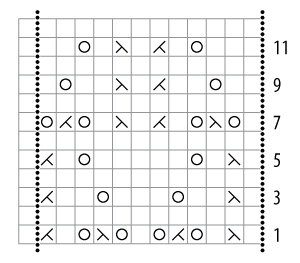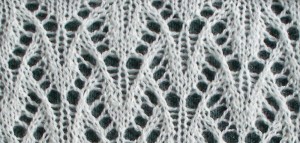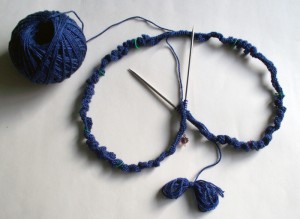Excuse me while I toot my own horn for a moment. Charts Made Simple has made two “best of 2011” book lists. Library Journal says:
Knitters who are intimidated by the shorthand found in knitting charts need look no further. This sounds like dry material, but Briar’s zeal for her topic makes this title not only a useful reference but also a surprisingly readable book about the art of knitting.
And Clara Parkes says:
JC Briar shepherded us into the New Year with this small but indispensable ode to charts. Agreed, charts aren’t the sexiest subject in the knitting world. But if you’re afraid of them, which many knitters are, a whole world of creative freedom will be lost to you. Know how to read a chart, fix one that’s not right, and create one that works for you, and the world is your oyster.
This book is like everything JC does: concise, efficient, flawless, and infinitely helpful. If charts really aren’t going away—and they aren’t—then this book is the best $17.95 you’ll ever spend.
Can you tell I’m thrilled? 🙂
Whoa
By JC | December 6, 2011
Have you seen this? And this? Stunning Escher-inspired patchwork blankets, made all the more impressive by the skillful use of textures: ribbing for feathers, seed stitch for scales, bobbles for eyes. I’ve always loved tessellations, and I’m utterly blown away by these knitted ones.
This is precisely the sort of knitted inspiration that I don’t dare show DH. He’d want his own fish/bird/lizard blanket ASAP. And right now I have about as much time for knitting a blanket’s worth of tessellations as I have for knitting an blanket’s worth of hexipuffs.
Speaking of hexipuffs… after finishing my second (and, so far, last) hexipuff, I tossed it over to DH in his easy chair so he could have a closer look. He had fun squishing it absent-mindedly as he sat reading. Two weeks later, that hexipuff is still there, on the arm of his easy chair. He still squishes it absent-mindedly while reading or watching TV, like it was some kind of cat toy for humans. Honestly? To photograph it for y’all, I had to steal it back briefly when he wasn’t looking. I wonder when/if he’ll tire of it and give it back…
The news is out: I get to be one of the designers in the 2012 Knit Purl Sock Club. In keeping with the theme of “Masterpieces,” each kit’s colorway and pattern will take inspiration from a famous work of art. I can’t tell you anything more than that – the specific works of art are all hush-hush – but it should be fun! Sign up now at Knit Purl.
Speaking of sign-ups… class sign-ups are goin’ strong for the DFW Fiber Fest. Just a few seats are left in Cast-on Cornucopia, Bind-off Bonanza, Get Twisted!, and Slick Set-in Sleeves. If you were thinking of signing up, now’s the time! Check out the DFW Fiber Fest website for more info.
Whew! Thirty days in NaBloPoMo, and thirty blog posts. (If you count this one. Which I will.) What have I learned from this experiment?
Posting daily is possible. But it’s not sustainable, not if I want posts with non-trivial knitting content. I mean, really, who wants multiple blog posts that all essentially say, “Nope, still not getting gauge yet”?
But blogging doesn’t have to be a chore. Posts don’t have to be rambling dissertations; they can actually be more satisfying when they’re focused and to the point.
And blogging might be a way for me to keep tabs on ideas. More to the point: searching through my blog for posts tagged with “ideas” might be a way to pull myself out of knitting doldrums, when I feel like knitting but I can’t find a single WIP or UFO to hold my interest. When in doubt, start a new project, right?
So I’ll keep on blogging, not on a daily basis but hopefully more frequently than my long-term average of just 3 or 4 times a month. As always… we’ll see what happens.
Bizarre
By JC | November 29, 2011
Yesterday I was with some new acquaintances when one of ’em asked me what I did for a living. The long answer would’ve been something like “I teach knitting, and I have a book that’s an extension of the teaching, and I used to tech edit knitting patterns but I quit that to have more time for writing, and sometimes I design patterns for sale.” But I went with the short answer instead: “I teach knitting.”
That did it. Those three little words were enough to generate a full range of responses. First, the positive:
“That is so cool!”
Well, yes, it is cool that I get to make a living doing something I enjoy.
Then, the not-so-positive:
“No offense, but I wouldn’t pay you to teach me to knit. I could learn from a book.”
Can’t argue with her there, really. I learned from books. (Still do!)
And finally, the bizarre:
“That is the weirdest job I’ve ever heard of! It’s even better than the one in Clerks, you know, the woman who manually masturbates caged animals.”
Uh… really?
I’m fairly used telling people what I do, and getting odd responses in return. Either they’re stunned by the idea of someone traveling to teach knitting, or by the idea of knitting conferences that attract hundreds or even thousands of knitters. (The only airplane seatmate that ever grokked the concept used to teach at quilt shows.)
But is teaching knitting really weirder than something Keven Smith dreamed up? Naw. I don’t think so.
One of the reasons I love charts is that they’re a sort of universal language. It doesn’t matter where a chart comes from – a publication written in English, German, Japanese, or whatever – I’m good to go as long as I have an English copy of the key, or a few good swatch photos and some willingness to guess.
That doesn’t mean chart symbols are universal. Take the chart for Half Leaf, as it appears in The Happsalu Shawl:
The chart is perfectly understandable if you have its key. Even without the key, experienced knitters can guess that a circle is a yarn over, a triangle that slants right is a k2tog, and a triangle that slants left is an ssk.
But pretty? Easy to work with? Not so much, IMHO. I find the chart too busy, too cluttered. I’m not keen on the heavy, dark squares for knit stitches.
No biggie. I can always redraw a chart, using symbols more to my liking:
Same chart, just presented in a less cluttered way. Now it’s easier to see where the patterning takes place.
Does this mean I think all charts should be drawn using the same symbols? Nope. I mean, consistency would be nice, but let’s face it: everybody has their own favorite symbols. (No doubt, my Half Leaf chart would look seriously weird to any knitter familiar with the circles, triangles, and squares in The Haapsalu Shawl.) I figure it’s best to be realistic, to expect to encounter charts whose symbols you don’t like… and to meet them head-on, with graph paper and pencil in hand if need be.
Yes, yes, I know I’m in the midst of an Estonian shawl, and that I just cast on for a Swirl. But that hasn’t stopped me from contemplating additional mischief, in the form of a scarf or maybe a shawl.
See, DH* and I are planning to take some time off together in December. And when we travel, we travel light – just carry-on. That dictates really small projects. A lace scarf is ideal: once the pattern is established, I can even leave the chart behind.
Clearly, the Estonian shawl won’t work as travel knitting. Soon, I’ll need to cast on for the edging, and that’s a task best tackled at home. And the Swirl? Soon, it’ll be far too large.
So I was thinking about what kind of scarf I’d like to start, when I was reminded of Half Leaf pattern.
As it turns out, Half Leaf repeats every 12 stitches and every 12 rows, making it an ideal candidate for working as a top-down triangular shawl. So I had some fun, charting out how the increases for a triangular shawl’s sections could best be incorporated into Half Leaf pattern. I have a chart that I like…
…but now I’m wondering if I should take along a UFO instead:
This multi-directional scarf doesn’t look much different than when I last blogged about it in July. Maybe it should have a turn. If nothing else, it would save me from having to swatch to figure out what yarn and needles to use for the Half Leaf shawl.
What would you do?
*Da Hubster
So I’ve started my next Swirl.
The butterfly is leftover tail from the long-tail cast-on. I could’ve used a separate ball for the cast-on tail, except I didn’t feel like winding another skein. (I’m not keen on using the outside and the inside of a center-pull ball – that has too much potential for tangling, IMHO.) So I cast on 10 stitches, then unraveled ’em to see how much tail they required. That let me estimate how much I’d need for the Swirl. As you can see, I estimated rather conservatively. Better than running short on tail, eh?
I haven’t yet trimmed off this excess tail because, as before, I was bold and daring (or stupid, depending on how you want to look at it) and didn’t take Sandra’s advice to work the first three rows flat before joining into a round. No, instead I just dove in and joined to work in the round from the get-go. This, of course, opens up the possibility that I’m not knitting a circle, but a twisted beast that would need to be ripped and re-started. I don’t think it likely, though. I checked carefully after finishing the first round, pinning down sections so I could see if the cast-on edge twisted around the needle on any section. All seemed well then. (If it had seemed twisted, I could’ve untwisted with no problem, as only a single strand of yarn connected the beginning and end of rounds at the join.) I’ll check again after completing several rounds, at which point any twisting will be more obvious. If it still looks good, then I’ll breathe a sign of relief, trim off the excess tail, and weave in the end.
As for my Estonian shawl… don’t worry, I’m still committed to finishing it, and I’m still making decent progress daily. I’d show you a photo, but until it’s finished and blocked all you’d see is a pile of white fluff.
As suspected, knitting from the center out gave me exactly the kind of hexipuff I wanted:
Vital stats: Blue Moon Fiber Arts Socks that Rock mediumweight and 3.25 mm needles (again, as with hexipuff #1). Pinhole start, kfb increases, k2tog decreases, and pinhole finish.
Working 6 increases on 2 of every 3 rounds gave the first side just the right flat shape; ditto 6 decreases on 2 of every 3 rounds on the second side. Why did this rate of shaping work out? Because it’s 12 increases or decreases every 3 rounds, which is the same as 4 increases or decreases every round, which generally creates a flat shape… more so in garter stitch than stockinette, but close enough for a little hexipuff.
I love that the hexipuff really is a hexagon, with each side the same as the others. I like the spiral design created by the shaping. And I really like the definition that one round of purl gave to the outer edge. It would be a perfect base for crocheted snowflake embellishments, don’t you think?
BTW, stuffing this hexipuff wasn’t as fiddly as I thought it might be. Then again, I cheated somewhat: instead of decreasing down to a tiny 6-stitch opening before stuffing, I decreased down to 12 stitches. That left me plenty of room to get the stuffing in there. And working one more decrease round wasn’t fiddly at all, even with the stuffing in place.
Will I make more hexipuffs, and sew them together? Not sure. But if I do, now I know the shaping approach I prefer.
Thankful
By JC | November 24, 2011
Happy Thanksgiving, everybody! I’m going to keep this short (and hopefully not too sappy), but let me say that as a knitter I’m grateful for the huge selection of yarn, needles and books available these days; for the breed-specific wools we’re starting to see, and for the people keeping those breeds alive and letting us know about them; for all the indie dyers that inspire us with their color magic; for the online resources that keep us in touch and informed; and for the opportunity to travel and connect with knitters at events around the country.
Now, if you’ll excuse me, I’m going to go be grateful that I have a few spare minutes to squeeze in some more knitting…








